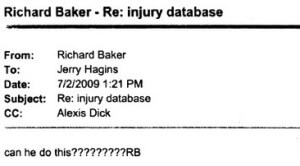Texas state officials surprised when public data is posted online by John Tedesco
Karisa King and I were cleaning our corner of the newsroom last week, and I rediscovered this gem of an e-mail written by an official for the Texas Department of Insurance.
The state agency oversees the amusement-ride industry. When a patron is seriously injured, the ride owner is supposed to report the injury to the department of insurance, and the information is typed into a database.
For a story I wrote about the safety of amusement rides, we obtained a copy of the injury database, and the Express-News posted the data online.
 That disturbed at least one state official.
That disturbed at least one state official.
“Tedeso has put together a searchable database of injuries from our data,” department spokesman Jerry Hagins informed his colleagues in the July 2009 e-mail.
“Can he do this?????????” replied Richard Baker, a manager at the agency.
A question with nine question marks deserves an answer: Yes, we can do this. In fact, news organizations and blogs ought to do this.
Related: Telling stories with data: Police chases and drug smugglers on the Texas-Mexico border
Government agencies collect reams of data about important issues. When journalists find that data, analyze it, and share it with the public, we help readers make sense of a complicated world. That’s our mission. And that’s why news sites are publishing “data centers” with unique and useful information.
Want to learn the salary of the city manager of San Antonio? Check a public-salary database.
Curious what litterbugs have been dumping on roadways? Check the state’s “Dont Mess with Texas” database.
Wondering where it’s safe to drive in San Antonio during a downpour? Check a map of low-water crossings, which was created from a city database.
Can we post this data?
Yep.
Should we?
Absolutely.



